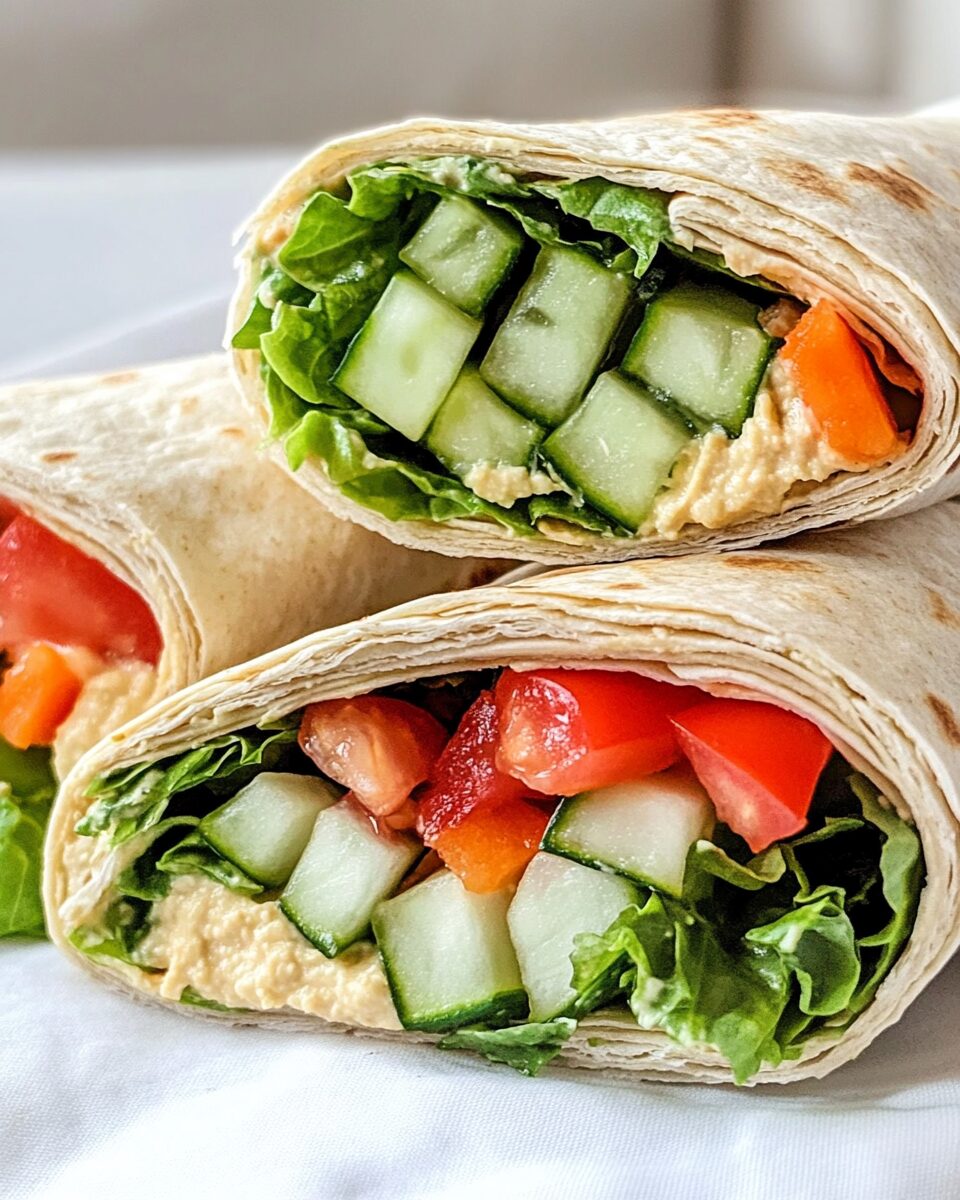This Hummus Pita Wrap is a fast, nutritious, and satisfying breakfast option that’s perfect for college students on the go. Packed with plant-based protein, fresh vegetables, and whole grains, it’s easy to assemble and great for busy mornings.
FULL RECIPE
Ingredients
- 1 whole wheat pita bread
- 3 tablespoons hummus
- 1/4 cup shredded lettuce
- 1/4 cup diced cucumber
- 1/4 cup chopped tomato
- 2 tablespoons shredded carrots
- 1 tablespoon crumbled feta cheese (optional)
- Salt and pepper to taste
- Dash of lemon juice (optional)
Directions
- Warm the pita bread slightly in a microwave or skillet until soft.
- Spread the hummus evenly over the inside surface of the pita.
- Layer the lettuce, cucumber, tomato, and carrots over the hummus.
- Add crumbled feta if using.
- Season with salt, pepper, and a dash of lemon juice if desired.
- Fold or roll the pita into a wrap and serve immediately.
Nutritional Information
- Calories: 250–300 kcal
- Protein: 7g
- Fat: 10g
- Carbohydrates: 35g
- Fiber: 6g
- Sugar: 4g
Nutritional Benefits of Hummus Pita Wrap
The hummus pita wrap is a powerhouse of nutrition, offering a balance of macronutrients that fuel your body efficiently. Hummus, made primarily from chickpeas, is rich in plant-based protein and fiber, which help with muscle repair and digestive health. The whole wheat pita provides complex carbohydrates that offer sustained energy release, perfect for busy mornings. Fresh vegetables like lettuce, cucumber, and tomato add essential vitamins, minerals, and antioxidants that support immune function and overall well-being. Additionally, the healthy fats from olive oil in hummus and optional feta cheese contribute to heart health and better absorption of fat-soluble vitamins.
Why Hummus is a Great Plant-Based Protein
Hummus is a delicious and versatile spread made from chickpeas, tahini, olive oil, lemon juice, and garlic. Chickpeas are an excellent source of plant-based protein, making hummus a nutritious option for vegetarians and vegans. The protein in chickpeas supports muscle growth and repair while also promoting satiety, helping you feel full longer. Unlike some animal proteins, chickpeas contain no cholesterol and are low in saturated fats, which benefits cardiovascular health.
The Role of Whole Wheat Pita Bread
Choosing whole wheat pita instead of white bread is a smart choice for improving diet quality. Whole wheat contains more fiber, vitamins, and minerals compared to refined grains. Fiber aids in digestion, helps regulate blood sugar, and promotes heart health. The pita acts as a convenient vehicle for the fillings, providing a chewy texture that complements the creamy hummus and crisp vegetables.
Vegetables: Freshness and Nutritional Value
Including fresh vegetables such as lettuce, cucumber, tomato, and carrots enhances the wrap’s nutritional profile. These vegetables are low in calories but high in water content and fiber, aiding in hydration and digestive health. Tomatoes are a great source of vitamin C and lycopene, an antioxidant linked to reduced risk of certain cancers. Carrots provide beta-carotene, which the body converts into vitamin A, essential for eye health and immune support.
The Impact of Feta Cheese
Feta cheese is a flavorful addition that adds a creamy texture and a slight tang to the wrap. While optional, feta contributes additional protein and calcium, supporting bone health. It contains beneficial probiotics that can aid digestion. However, it also increases the sodium content, so it’s best to use it in moderation, especially for those monitoring their salt intake.
Hummus Variations to Try
The basic hummus recipe can be varied in numerous ways to suit different tastes and dietary needs. You can add roasted red peppers, sun-dried tomatoes, or fresh herbs like cilantro and parsley to enhance the flavor. For those who enjoy spice, a sprinkle of cayenne pepper or a dash of hot sauce works well. These variations not only make the wrap more interesting but can also add additional nutrients.
The Convenience Factor for College Students
This wrap is ideal for college students due to its simplicity and speed of preparation. It requires minimal cooking skills and can be made in under 10 minutes. It’s portable and mess-free, making it easy to eat between classes or during study sessions. This convenience encourages healthier eating habits compared to fast food or vending machine snacks.
Meal Prep Friendly
The hummus pita wrap is perfect for meal prepping. You can prepare the vegetables and hummus ahead of time, and assemble the wrap fresh each morning. Storing hummus in airtight containers keeps it fresh for several days, and chopping vegetables in advance saves precious time. This makes it easier to maintain a nutritious diet even on the busiest days.
Balancing Macronutrients
This wrap provides a good balance of carbohydrates, proteins, and fats, which is essential for sustained energy and overall health. The fiber-rich carbs from the pita and vegetables help maintain steady blood sugar levels. The protein from hummus and optional feta supports muscle maintenance and keeps hunger at bay. Healthy fats from olive oil in hummus promote brain function and hormone production.
Dietary Considerations
This recipe is naturally vegetarian and can easily be made vegan by omitting feta cheese. It is also gluten-friendly if you choose gluten-free pita bread. For those watching their sodium intake, reducing or skipping added salt and cheese can make it heart-healthier. The wrap can be adapted to fit various dietary restrictions while still being delicious and satisfying.
Hydration Benefits from Vegetables
The high water content in the fresh vegetables adds a hydration boost to the meal, which is often overlooked in breakfast choices. Proper hydration is crucial for cognitive function and energy levels, especially for students who need to stay alert throughout the day. The crisp texture of vegetables also adds freshness that balances the creamy hummus.
Antioxidant Content
The vegetables and hummus together provide a variety of antioxidants that combat oxidative stress in the body. Lycopene from tomatoes, beta-carotene from carrots, and vitamin C from cucumbers contribute to reducing inflammation and protecting cells from damage. Regular intake of antioxidants is linked to lower risks of chronic diseases such as heart disease and cancer.
Sustainability and Ethical Eating
Choosing a meal centered around plant-based ingredients like hummus aligns with more sustainable and ethical eating habits. Chickpeas require less water and land to produce compared to animal-based proteins, making them environmentally friendly. This recipe promotes a lower carbon footprint without sacrificing taste or nutrition.
Customizing Your Wrap
One of the great things about this wrap is how customizable it is. You can easily add or swap vegetables based on what you have available or what’s in season. Spinach, bell peppers, or avocado slices make excellent additions. Adjusting the level of hummus or cheese can also tailor the wrap to your taste preferences and calorie needs.
Pairing with Beverages
This wrap pairs well with a variety of beverages. A glass of fresh fruit juice or a smoothie complements the meal by adding extra vitamins and natural sweetness. For those who prefer savory options, herbal teas or black coffee are great choices. Hydrating drinks help balance the fiber-rich meal and keep you refreshed.
Portion Control and Satiety
The combination of fiber, protein, and fats in the wrap promotes a feeling of fullness that helps with portion control throughout the day. This can prevent overeating later and support weight management goals. Eating a balanced breakfast like this wrap stabilizes energy and mood, which is important for academic performance.
The Role of Lemon Juice
Adding a dash of lemon juice brightens the flavors and provides a boost of vitamin C. The acidity also helps balance the richness of hummus and cheese, making the wrap more refreshing. Lemon juice aids digestion and can enhance nutrient absorption, particularly iron from plant-based sources.
Cost-Effectiveness
This recipe is budget-friendly, relying on affordable staple ingredients like chickpeas and pita bread. Buying vegetables in season or frozen can further reduce costs. Making your own hummus at home can be cheaper and healthier than store-bought versions, providing better control over ingredients.
Cultural Significance of Hummus
Hummus is a staple in Middle Eastern cuisine and has gained worldwide popularity for its taste and nutritional value. It connects you to rich culinary traditions and offers a delicious way to explore global flavors. Using pita bread alongside hummus reflects authentic serving styles and adds cultural appreciation to your meal.
Storage and Leftovers
If you have leftovers, hummus keeps well refrigerated for up to a week. Vegetables should be stored separately to avoid sogginess. Assembling the wrap just before eating preserves the texture and flavor. This flexibility makes the wrap a practical choice for those managing time and resources.
Conclusion
The hummus pita wrap is a nutritious, quick, and adaptable meal ideal for busy lifestyles, especially college students. It combines wholesome ingredients that nourish the body while being easy to prepare and enjoy anywhere. Its rich nutrient content supports sustained energy, digestive health, and overall well-being. By choosing fresh vegetables and quality ingredients, this wrap offers a balanced, tasty option that fits various dietary needs and preferences. Its affordability, sustainability, and cultural roots make it not just a meal, but a mindful choice that contributes to health and enjoyment every day.






